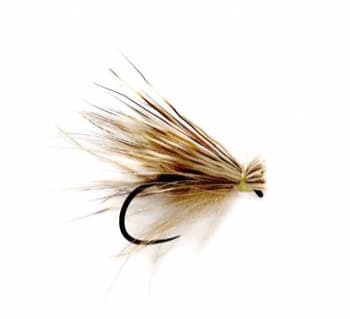
The fly pattern chosen for the November tying session is the CDC Elk Hair Caddis. Fall water temperatures make caddisfly patterns i.e. the CDC Elk Hair Caddis a perfect candidate for fishing some of our local streams. Just as adult caddis flies can expertly travel the waves and are very tempting for trout, the CDC Elk Hair Caddis is the ideal fly pattern to use in the cooler and more turbulent waters of the fall. The CDC Elk Hair Caddis is quite similar to the standard Elk Hair Caddis but differs in that the underwing (under the elk hair) is CDC which stands for cul le de canard (i.e. French for butt of a duck). And because of their structure and water shedding properties, incorporation of the CDC feathers provide additional buoyancy to the fly.
Materials:
- Hook – Standard dry fly hook e.g. Mustad 94831 sizes 10-16.
- Thread – 6/0 or 140 denier, color to match abdomen (dubbing)
- Abdomen – dry fly dubbing w/wo antron
- CDC feather – light brown, tan, natural
- Wing – elk body hair (color to match the abdomen)
Tying Steps:
- After pinching down the hook barb, insert hook in tying vise and start wrapping tying thread around hook shank beginning slightly behind the hook eye, proceeding toward the hook bend. Stop thread wraps directly above the hook barb.
- Select a single CDC feather and flare the feather barbules out slightly by drawing the feather between your fingers. Then place the feather (concave side down) at the rear of the hook, with the base of the feather toward the rear and only the tip of the feather lying along the rear of the hook where the thread is hanging.
- Hold the feather firmly in place with the left hand and make several thread wraps forward over the feather tip (wrapping forward toward the hook eye). This should only be about 1/8”.
- Apply a light layer of dubbing on the tying thread, leaving about ¼” of bare thread close to the hook. Make several thread wraps toward the hook bend over the CDC feather tip and then continue forward with the dubbed portion of the thread creating a thin tapered abdomen as the dubbed thread is wrapped toward the hook eye, stopping ~1/4” behind the hook eye.
- Using hackle pliers wrap the CDC feather (palmering) forward around the hook shank, while gently stroking the CDC fibers toward the rear of the hook with each successive wrap of CDC.
- Stop the CDC wrap at the same location where the dubbing was stopped. Trap the CDC feather butt with several wraps of thread and cut off the excess feather.
- Stack a small amount of elk hair (~diameter of a small wooden pencil) in hair stacker. Trim the butt ends of the elk hair bundle and measure the length of the stacked hair such that the tips are even with the hook bend.
- Grasp the hair bundle firmly between forefinger and thumb of the left hand. Then hold the bundle immediately above the hook shank and make one light wrap around the bundle (but not around the hook shank).
- Draw the bundle of hair down on top of the hook shank and make two more wraps of thread around the hair bundle and the hook shank. (At this point the hair bundle is relatively loosely secured to the top of the hook shank). Make a third wrap around the hook shank pulling directly upward (after circling the hook shank) while firmly holding the hair bundle tight with the left hand (fingers) to keep it directly on top of the hook. (The upward pressure of the thread, draws the thread bundle downward on the hook shank rather than around the hook shank).
- Then make several additional wraps of thread through the butt ends of the elk hair bundle and secure the thread with either whip finisher or half-hitch tool.
- Clip off any elk hair which is forward of the hook eye. I like to then apply a drop of epoxy or head cement on the top and underside of the thread wraps.
- Also trim off any straggling elk hair fibers which are on the underside of the hook.
— Don Fine
You must be logged in to post a comment.